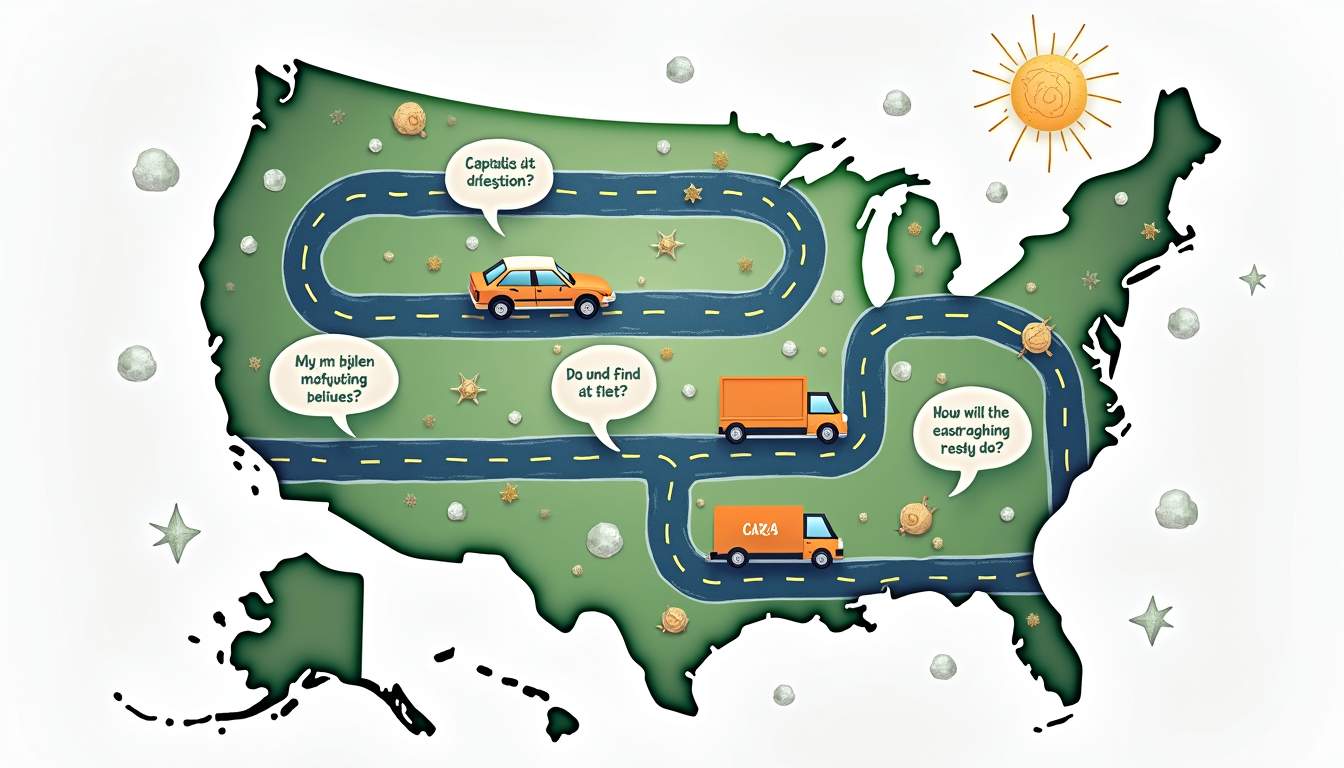Shipping a car across the country can be daunting, filled with potential pitfalls that can lead to stress and unexpected costs. Understanding the common mistakes that many people make during this process can help ensure a smoother experience. This article outlines key areas to focus on, providing insights to avoid common errors when shipping a vehicle.
1. Common Car Shipping Mistakes
Not Obtaining Multiple Transport Quotes
One of the most frequent mistakes made when shipping a car is failing to obtain multiple transport quotes. Many individuals settle for the first quote they receive, which can lead to overpaying for services. By gathering quotes from different carriers, you can compare prices, services, and delivery times, ensuring you make an informed decision that best fits your needs.
Moreover, different transport companies may offer varying levels of service, and a lower price does not always equate to better value. Taking the time to research and compare can save you money and provide peace of mind. Compare transport options and get a fair price with our helpful Cost to Ship a Car guide.
Prioritizing Cost Over Service Reputation
While cost is an important factor in choosing a car shipping service, prioritizing it over the company’s reputation can lead to significant issues. A low-cost service may cut corners, resulting in poor handling of your vehicle or delays in delivery. It is essential to consider customer reviews, ratings, and overall service quality when making your selection.
Investing in a reputable shipping company can prevent potential headaches and ensure your vehicle arrives safely and on time. Look for testimonials and feedback from past customers to gauge the reliability of the service. Choose reliable services by learning how our State-to-State Auto Transport ensures quality transport for your vehicle.
Choosing Inappropriate Shipping Services
Not all shipping services are created equal, and selecting the wrong type can lead to complications. For instance, opting for open transport may be suitable for standard vehicles, but luxury or classic cars may require enclosed transport for added protection. Understanding the specific needs of your vehicle is crucial in making the right choice.
Additionally, consider the distance and route of your shipment. Some companies specialize in long-distance transport, while others may be better suited for local moves. Researching and selecting the appropriate service can make a significant difference in the shipping experience. Understand the difference between open and enclosed shipping in our Enclosed Auto Transport Carriers overview.
2. Insurance and Documentation Pitfalls
Understanding Car Shipping Insurance Coverage
Another critical area where mistakes often occur is in understanding car shipping insurance coverage. Many individuals assume that their auto insurance will cover any damages during transport, but this is not always the case. It is essential to verify what type of coverage is provided by the shipping company and whether additional insurance is necessary.
Inquire about the carrier’s insurance policy, including what it covers and any deductibles that may apply. This knowledge can help you make informed decisions about your coverage options and ensure your vehicle is adequately protected during transit. Make informed decisions about insurance coverage using our guide on How Auto Transport Works.
Ensuring Vehicle Documentation is Complete
Proper documentation is vital when shipping a car. Failing to provide complete and accurate paperwork can lead to delays or complications at pickup and delivery. Ensure that all necessary documents, such as the vehicle title, registration, and proof of insurance, are readily available and in order.
Additionally, it’s wise to keep copies of all documentation for your records. This can help resolve any disputes that may arise during the shipping process and provide peace of mind knowing that everything is accounted for.
Documenting Pre-Existing Vehicle Damage
Before handing over your vehicle to the shipping company, it is crucial to document any pre-existing damage. Taking clear photographs of your car from multiple angles can serve as evidence should any issues arise during transport. This step is often overlooked, but it can be invaluable in protecting your interests.
Having a detailed record of your vehicle’s condition can expedite the claims process if damage occurs during shipping. Ensure that you share this documentation with the carrier and retain copies for your records.
3. Preparing Your Vehicle for Transport
Removing Personal Items from the Vehicle
One common oversight when preparing a vehicle for transport is leaving personal items inside. Most shipping companies advise against this, as personal belongings can shift during transport and cause damage to the vehicle or items themselves. Furthermore, carriers typically do not cover loss or damage to personal items.
To avoid potential issues, remove all personal items from the vehicle before shipping. This includes valuables, electronics, and any other belongings that could be affected during transit.
Maintaining Fuel and Fluid Levels
Another important aspect of vehicle preparation is ensuring that fuel and fluid levels are appropriate. Most shipping companies recommend keeping the fuel tank at about a quarter full. This amount is sufficient for loading and unloading without adding unnecessary weight, which can affect transport costs.
Additionally, check all fluid levels, including oil, coolant, and brake fluid, to ensure they are topped off. This precaution helps prevent any mechanical issues during transport and ensures that your vehicle is in good condition upon arrival.
Conducting a Thorough Vehicle Inspection
Before shipping your car, conduct a thorough inspection to identify any existing issues. Check for scratches, dents, and any mechanical problems that may need addressing. Document these findings with photographs and notes to have a comprehensive record of your vehicle’s condition.
Communicating any pre-existing issues to the shipping company can also help them handle your vehicle with extra care. This proactive approach can prevent misunderstandings and ensure that your vehicle is treated appropriately during transport.
4. Booking and Scheduling Challenges
Avoiding Last-Minute Shipping Decisions
Last-minute decisions can lead to rushed choices and costly mistakes when shipping a car. It is advisable to plan ahead and book your transport well in advance. This approach not only allows for better pricing options but also provides ample time to gather necessary documentation and prepare your vehicle.
By avoiding hasty decisions, you can ensure that you have chosen the right shipping service and that all aspects of the process are handled efficiently.
Planning for Seasonal Pricing Changes
Understanding seasonal pricing changes is another critical factor in booking vehicle transport. Rates can fluctuate based on demand, with peak seasons often resulting in higher costs. For instance, summer months may see an increase in shipping prices due to higher demand for vehicle transport.
Planning your shipment during off-peak times can lead to significant savings. Researching and understanding these trends can help you make informed decisions about when to schedule your vehicle transport.
Clarifying Delivery Time Expectations
Clear communication regarding delivery time expectations is essential. Many factors can influence delivery times, including distance, weather conditions, and traffic. It is crucial to discuss and clarify these expectations with the shipping company before finalizing your booking.
Having a realistic understanding of the timeline can help you plan accordingly and reduce anxiety about when your vehicle will arrive. Ensure that you have a contact person at the shipping company to keep you updated on any changes.
5. Communication and Delivery Best Practices
Establishing Clear Communication with Carriers
Effective communication with the shipping carrier is vital throughout the transport process. Establishing a clear line of communication can help address any concerns or questions that may arise. Make sure to have the contact information of the driver or dispatcher and feel free to reach out for updates.
Being proactive in communication can help ensure that any issues are resolved quickly and that you remain informed about the status of your vehicle during transport.
Coordinating Flexible Delivery Options
Flexibility can be beneficial when arranging for vehicle delivery. Discussing delivery options with the carrier can help accommodate your schedule and preferences. Some carriers offer terminal-to-terminal delivery, while others provide door-to-door service.
Understanding the available options and coordinating them with your needs can lead to a more convenient and satisfactory shipping experience. Explore the convenience of door-to-door service by checking out our Open Auto Carrier Transportation page.
Being Present for Vehicle Handover
Being present during the vehicle handover is crucial for ensuring that everything goes smoothly. This allows you to inspect the vehicle upon delivery and address any concerns immediately. If you cannot be there in person, consider having a trusted friend or family member present to oversee the handover.
Conducting a thorough inspection at the time of delivery can help identify any potential issues and provide an opportunity to document the vehicle’s condition upon arrival. This step is essential for protecting your investment and ensuring a successful shipping experience.
6. Essential Questions to Consider
What Mistakes Should Be Avoided When Shipping?
Understanding the common mistakes that can occur during the car shipping process is essential for a successful experience. Key errors to avoid include not obtaining multiple quotes, neglecting to verify insurance coverage, and failing to prepare your vehicle adequately. By being aware of these pitfalls, you can take proactive steps to mitigate risks.

How Far in Advance Should Shipments Be Booked?
It is generally advisable to book your vehicle shipment at least two to four weeks in advance. This timeframe allows ample opportunity to compare quotes, gather necessary documentation, and prepare your vehicle for transport. Booking early can also help secure better rates and availability.
What Documentation is Required for Shipping?
Essential documentation for shipping a car typically includes the vehicle title, registration, proof of insurance, and a bill of lading. Ensuring that all paperwork is complete and accurate is vital for a smooth shipping process. It is also beneficial to keep copies of all documents for your records.
What Steps Are Needed for Vehicle Preparation?
Preparing your vehicle for transport involves several key steps. These include removing personal items, checking fluid levels, conducting a thorough inspection, and documenting any pre-existing damage. Taking these precautions can help ensure that your vehicle is ready for transport and minimize potential issues during the shipping process.
In conclusion, shipping a car across the country requires careful planning and attention to detail. By avoiding common mistakes and following best practices, individuals can ensure a smoother experience and protect their investment. Understanding the process, preparing adequately, and maintaining clear communication with the shipping company are essential components of a successful vehicle transport.

